1990 VOLKSWAGEN TRANSPORTER stop start
[x] Cancel search: stop startPage 70 of 165
![VOLKSWAGEN TRANSPORTER 1990 T4 / 4.G Owners Manual Downloaded from www.Manualslib.com manuals search engine
3REAK-IN
PERIOD
VEHICLE
OPERATION]
DURING AND
AFTER
BREAK-IN PERIOD
Turing
the first few operating
hours,
the
r-gines
internal VOLKSWAGEN TRANSPORTER 1990 T4 / 4.G Owners Manual Downloaded from www.Manualslib.com manuals search engine
3REAK-IN
PERIOD
VEHICLE
OPERATION]
DURING AND
AFTER
BREAK-IN PERIOD
Turing
the first few operating
hours,
the
r-gines
internal](/manual-img/18/7415/w960_7415-69.png)
Downloaded from www.Manualslib.com manuals search engine
3REAK-IN
PERIOD
VEHICLE
OPERATION]
DURING AND
AFTER
BREAK-IN PERIOD
Turing
the first few operating
hours,
the
r-gine's
internal friction is higher than
a:er
when all the moving parts
have
been
:-oken
in. How well this break-in
process
e
done
depends
to a
considerable
extent
:n
the way the
vehicle
is driven during the
-"-3t
900
miles
(1500 kilometers).
For
the first 600 miles
(1000 kilometers):
•
Do not use full
throttle.
•
Do not drive faster
than
3A of top
speed.
•
Avoid high engine speeds.
From
600 to 900 miles
(1000 to 1500 kilometers):
The
speed
can gradually be
increased
to
:he
maximum road
speed
or
engine
speed.
After break-in period
The maximum permissible engine speed
is
5200
rpm and should not be exceeded.
Shift into the higher gear before reaching the red area at the end of the scale of
the tachometer. See page 41.
Excessive
engine
speeds
are automati
cally
reduced.
•
Details
on how to operate the
Manual
and
Automatic
transmission
are outlined
in
the
"Controls
and
equipment"
chapter.
•
Avoid full
throttle
starts and abrupt
stops.
•
Try to avoid running the engine at
maximum speed. Shifting up early helps
to save fuel and reduces noise.
•
Do not overstrain engine; select pro
per gear before reaching top speeds.
•
Do not let engine labor. Shift down
when engine no longer runs smoothly.
•
All
revs
are only
valid
when
engine
is
properly
warm.
•
Always
observe
local
and national
speed
limits.
Applies
in addition to vehicles
with
Automatic
Transmission:
Make
it a habit to
accelerate
gradually
instead
of
using
full throttle. During
gra
dual
acceleration
the
transmission
shifts
earlier
into the next higher
gear
thus
saving
fuel.
WARNING
•
New tires do not
possess
maximum
traction. They tend to be slippery. Break new tires in by driving cautiously
at moderate speed for the first 100 miles (160 kilometers).
•
New brake pads and linings do not
have optimum friction properties and
must be "broken in" during the
initial
100 to 150 miles (150 to 200 kilometers)
of normal city driving. You can compen sate for this by applying more pressure
on
the brake pedal. This also applies
later
when new pads or linings are
installed.
www.westfaliaT3.info - a useful website for owners and enthusiasts of VW Westfalia T25 / T3 Campervans
Page 72 of 165
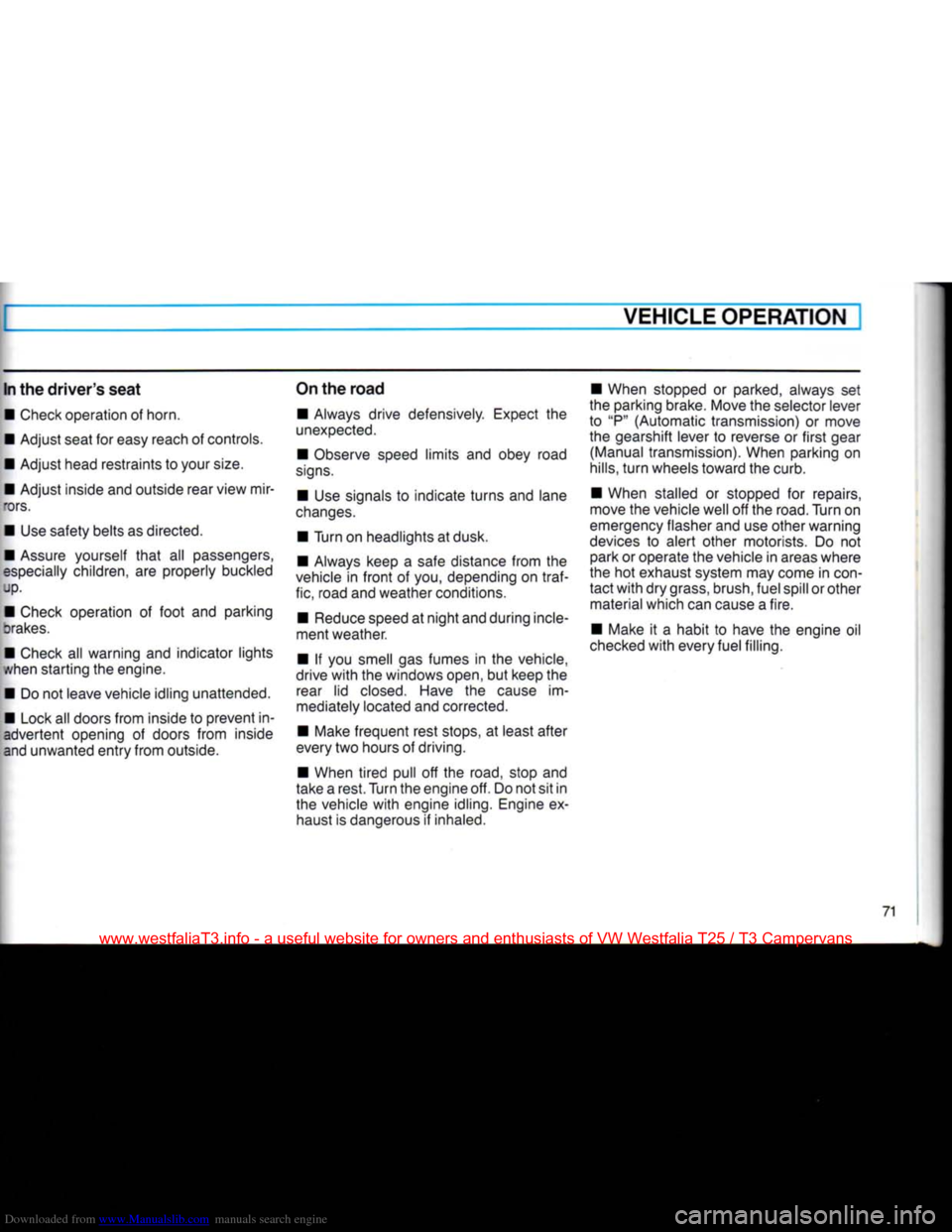
Downloaded from www.Manualslib.com manuals search engine
VEHICLE
OPERATION
In the
driver's
seat
•
Check operation of horn.
•
Adjust seat for easy reach of controls.
•
Adjust head restraints to your
size.
•
Adjust inside and outside rear view mir-
brs.
•
Use safety belts as directed.
•
Assure yourself
that
all passengers,
especially
children, are properly buckled up.
•
Check operation of
foot
and parking
orakes.
•
Check all warning and indicator lights
v/hen starting the engine.
•
Do not leave vehicle idling unattended.
•
Lock all doors
from
inside to prevent in advertent opening of doors
from
inside
and unwanted
entry
from
outside. On the
road
•
Always drive defensively. Expect the
unexpected.
•
Observe speed
limits
and obey road
signs.
•
Use signals to indicate
turns
and lane
changes.
•
Turn on headlights at dusk.
•
Always keep a safe distance
from
the
vehicle in
front
of you, depending on
traf
fic, road and weather conditions.
•
Reduce speed at
night
and during incle
ment weather.
•
If you smell gas fumes in the vehicle,
drive
with
the windows open, but keep the rear lid
closed.
Have the cause im
mediately located and corrected.
•
Make frequent rest stops, at least
after
every two hours of driving.
•
When
tired
pull off the road, stop and
take a rest. Turn the engine off. Do not sit in the vehicle
with
engine idling. Engine exhaust is dangerous if inhaled.
•
When stopped or parked, always set
the parking brake. Move the selector lever
to "P" (Automatic transmission) or move
the gearshift lever to reverse or
first
gear (Manual transmission). When parking on
hills,
turn
wheels
toward
the curb.
•
When stalled or stopped for repairs,
move the vehicle well off the road. Turn on
emergency flasher and use other warning
devices
to alert other motorists. Do not park or operate the vehicle in areas where
the hot exhaust system may come in
con
tact
with
dry
grass,
brush, fuel spill or other material which can cause a fire.
•
Make it a habit to have the engine oil
checked
with
every fuel filling.
www.westfaliaT3.info - a useful website for owners and enthusiasts of VW Westfalia T25 / T3 Campervans
Page 73 of 165
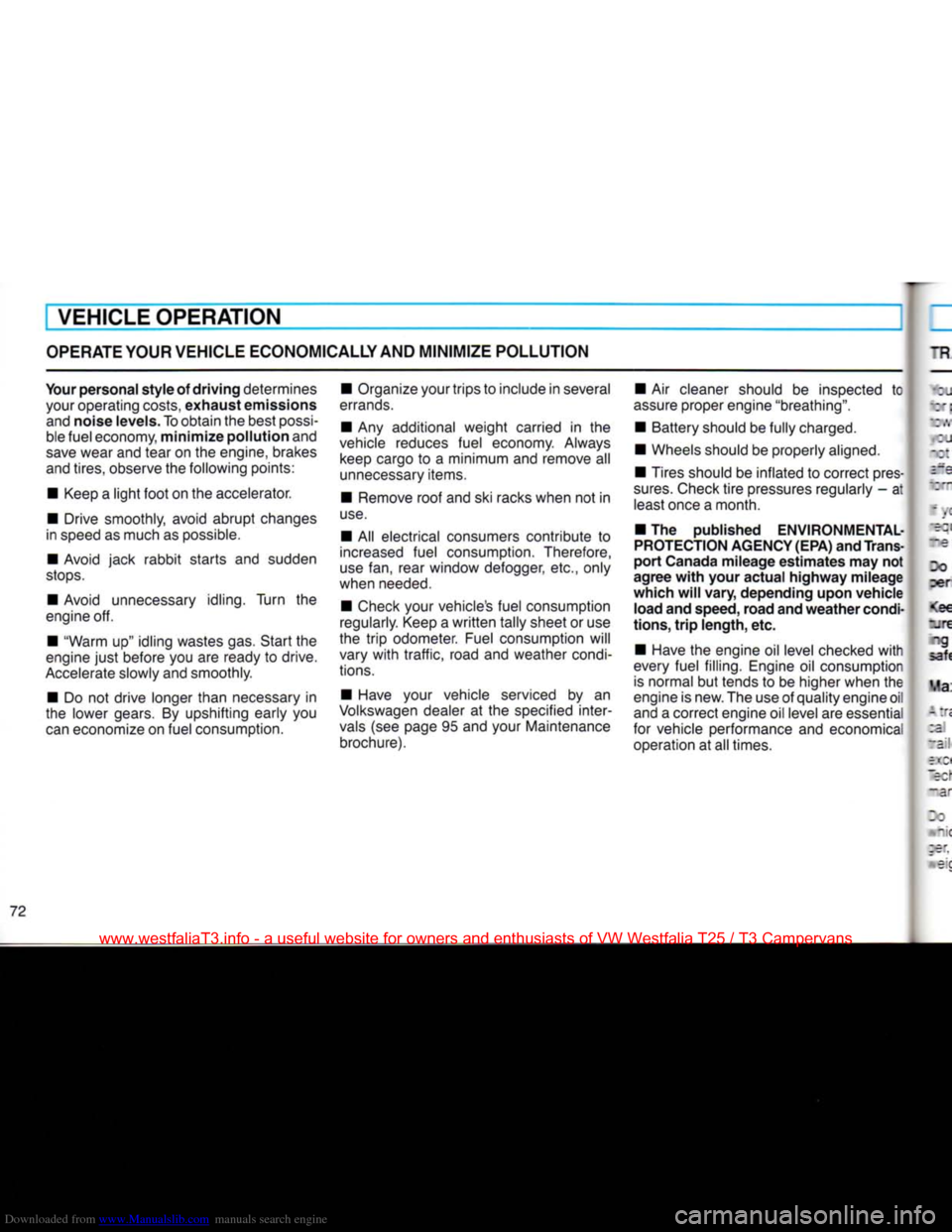
Downloaded from www.Manualslib.com manuals search engine
VEHICLE OPERATION
OPERATE
YOUR VEHICLE ECONOMICALLY AND
MINIMIZE
POLLUTION
Your
personal
style
of
driving
determines your operating costs,
exhaust
emissions and noise levels. To obtain the best
possi
ble fuel economy,
minimize
pollution
and
save
wear and tear on the engine, brakes
and tires, observe the following points:
• Keep a
light
foot
on the accelerator.
• Drive smoothly, avoid abrupt changes
in speed as much as possible.
• Avoid jack rabbit starts and sudden
stops.
• Avoid unnecessary idling. Turn the
engine off.
• "Warm up" idling wastes gas. Start the
engine
just
before you are ready to drive.
Accelerate
slowly and smoothly.
• Do not drive longer than necessary in
the lower gears. By upshifting early you
can
economize on fuel consumption. • Organize your trips to include in several
errands.
• Any additional weight carried in the
vehicle reduces fuel economy. Always keep cargo to a minimum and remove all
unnecessary
items.
• Remove roof and ski racks when not in
use.
• All electrical consumers contribute to
increased
fuel consumption. Therefore,
use
fan, rear window defogger, etc., only
when needed.
• Check your vehicle's fuel consumption
regularly. Keep a
written
tally sheet or use
the
trip
odometer. Fuel consumption will
vary
with
traffic, road and weather condi
tions.
• Have your vehicle serviced by an
Volkswagen
dealer at the specified inter
vals
(see page 95 and your Maintenance brochure). • Air cleaner should be inspected to
assure
proper engine "breathing".
• Battery should be fully charged.
• Wheels should be properly aligned.
• Tires should be inflated to correct pres
sures.
Check
tire
pressures regularly - at least once a month.
• The published ENVIRONMENTAL-
PROTECTION AGENCY (EPA) and Trans
port
Canada
mileage
estimates
may not
agree
with
your
actual
highway
mileage
which
will
vary,
depending
upon
vehicle
load
and speed,
road
and
weather
condi
tions,
trip
length,
etc.
• Have the engine oil level checked
with
every fuel filling. Engine oil consumption
is
normal but tends to be higher when the
engine is new. The use of quality engine oil
and a correct engine oil level are essential
for vehicle performance and economical operation at all times.
72
www.westfaliaT3.info - a useful website for owners and enthusiasts of VW Westfalia T25 / T3 Campervans
Page 75 of 165
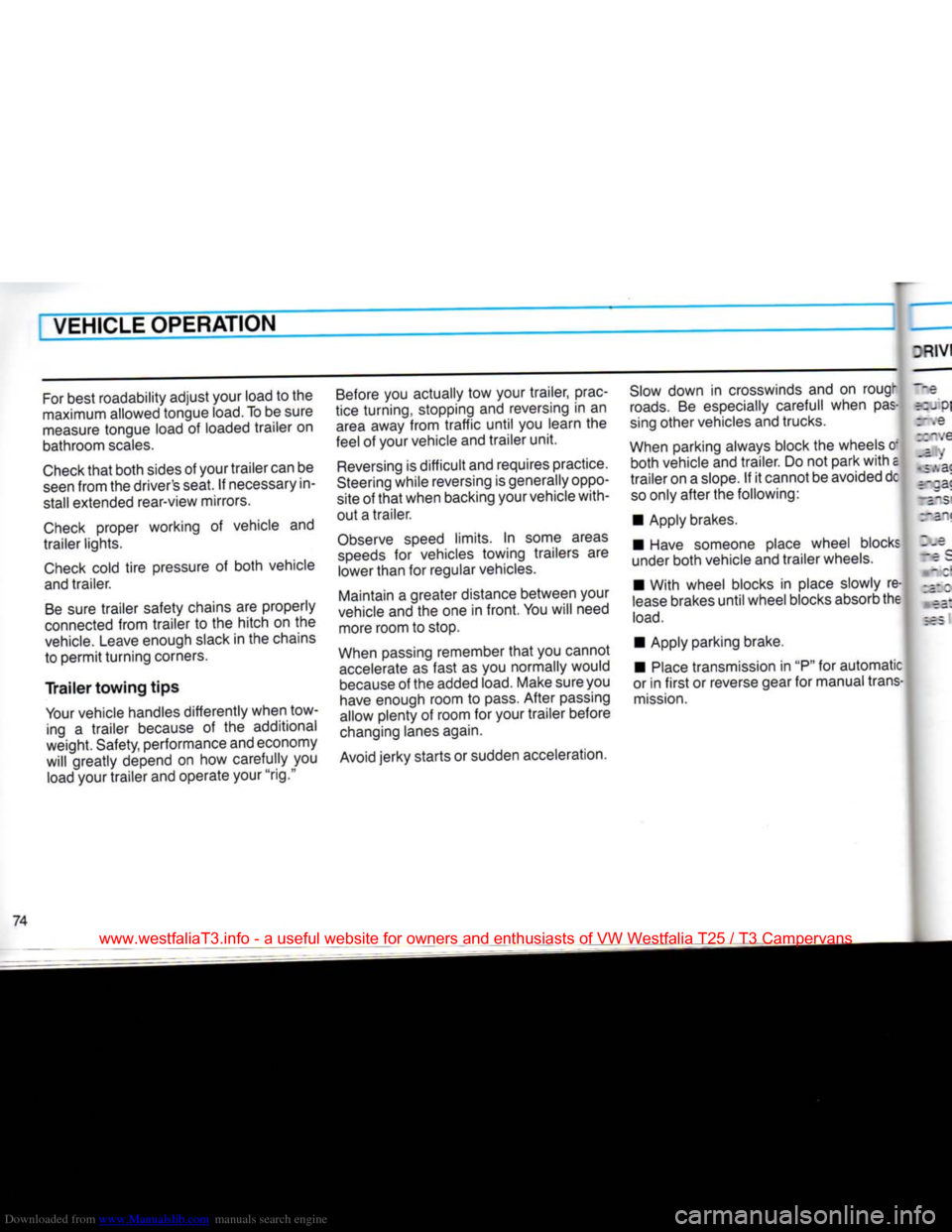
Downloaded from www.Manualslib.com manuals search engine
VEHICLE OPERATION
For
best roadability adjust your load to the
maximum allowed tongue load. To be sure
measure
tongue load of loaded trailer on
bathroom
scales.
Check
that
both sides of your trailer can be
seen
from the driver's seat. If necessary in
stall extended rear-view mirrors.
Check
proper working of vehicle and
trailer lights.
Check
cold
tire
pressure of both vehicle
and
trailer.
Be
sure trailer safety chains are properly
connected
from trailer to the hitch on the
vehicle.
Leave enough slack in the chains
to permit turning corners.
Trailer
towing
tips
Your
vehicle handles differently when tow ing a trailer because of the additional
weight. Safety, performance and economy
will greatly depend on how carefully you
load
your trailer and operate your "rig."
Before
you actually tow your trailer, prac
tice turning, stopping and reversing in an
area
away from
traffic
until
you learn the
feel of your vehicle and trailer
unit.
Reversing
is
difficult
and requires practice.
Steering
while reversing is generally oppo
site of
that
when backing your vehicle with
out a trailer.
Observe
speed limits. In some areas
speeds
for vehicles towing trailers are lower than for regular vehicles.
Maintain a greater distance between your
vehicle
and the one in
front.
You will need more room to stop.
When
passing remember
that
you cannot
accelerate
as fast as you normally would
because
of the added load. Make sure you
have
enough room to
pass.
After passing
allow plenty of room for your trailer before
changing
lanes again.
Avoid
jerky starts or sudden acceleration.
Slow
down in crosswinds and on rougi"
roads.
Be especially carefull when
pas
sing
other vehicles and trucks.
When
parking always block the wheels o: both vehicle and trailer. Do not park
with
a
trailer on a slope. If it cannot be avoided dc
so
only after the following:
• Apply brakes.
• Have someone place wheel blocks
under both vehicle and trailer wheels.
• With wheel blocks in place slowly re
lease
brakes
until
wheel blocks absorb the
load.
• Apply parking brake.
•
Place
transmission in
"P"
for automatic
or in
first
or reverse gear for manual trans
mission.
74
www.westfaliaT3.info - a useful website for owners and enthusiasts of VW Westfalia T25 / T3 Campervans
Page 79 of 165
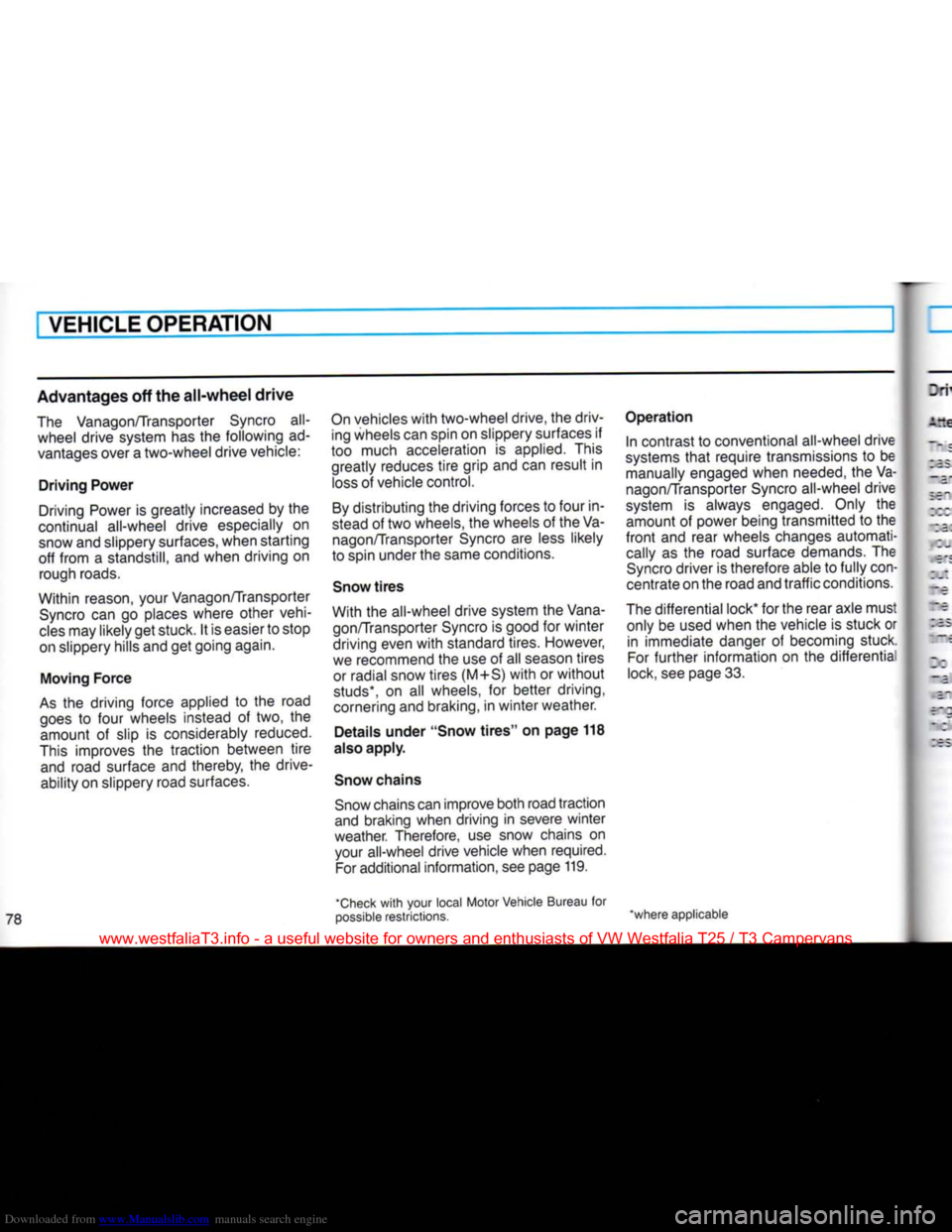
Downloaded from www.Manualslib.com manuals search engine
VEHICLE OPERATION
Advantages off the all-wheel drive
The Vanagon/Transporter Syncro
all-
wheel drive system
has the
following
ad
vantages over
a
two-wheel drive vehicle:
Driving Power
Driving Power
is
greatly increased
by the
continual all-wheel drive especially
on
snow
and
slippery surfaces, when starting
off from
a
standstill,
and
when driving
on
rough roads.
Within reason, your Vanagon/Transporter Syncro
can go
places where other
vehi
cles
may
likely
get
stuck.
It is
easier
to
stop
on slippery hills
and get
going again.
Moving Force
As
the
driving force applied
to the
road goes
to
four wheels instead
of two, the
amount
of
slip
is
considerably reduced.
This improves
the
traction between tire and road surface
and
thereby,
the
drive-
ability
on
slippery road surfaces. On vehicles with two-wheel drive,
the
driv
ing wheels
can
spin
on
slippery surfaces
if
too much acceleration
is
applied. This
greatly reduces tire grip
and can
result
in
loss
of
vehicle control.
By distributing
the
driving forces
to
four
in
stead
of two
wheels,
the
wheels
of the
Va nagon/Transporter Syncro
are
less likely
to spin under
the
same conditions.
Snow tires
With
the
all-wheel drive system
the
Vana gon/Transporter Syncro
is
good
for
winter
driving even with standard tires. However,
we recommend
the use of all
season tires
or radial snow tires (M
+
S) with
or
without
studs*,
on all
wheels,
for
better driving,
cornering
and
braking,
in
winter weather.
Details under "Snow tires"
on
page
118
also apply.
Snow chains
Snow chains can improve both road traction
and braking when driving
in
severe winter
weather. Therefore,
use
snow chains
on
your all-wheel drive vehicle when required. For additional information,
see
page
119.
Operation
In contrast
to
conventional all-wheel drive
systems that require transmissions
to be
manually engaged when needed,
the Va
nagon/Transporter Syncro all-wheel drive
system
is
always engaged. Only
the
amount
of
power being transmitted
to the
front
and
rear wheels changes automati cally
as the
road surface demands.
The
Syncro driver
is
therefore able
to
fully
con
centrate
on the
road and traffic conditions.
The differential lock*
for the
rear axle must only
be
used when
the
vehicle
is
stuck
or
in immediate danger
of
becoming stuck. For further information
on the
differential
lock,
see
page
33.
78 "Check with your local Motor Vehicle Bureau
for
possible restrictions.
'where applicable
www.westfaliaT3.info - a useful website for owners and enthusiasts of VW Westfalia T25 / T3 Campervans
Page 102 of 165
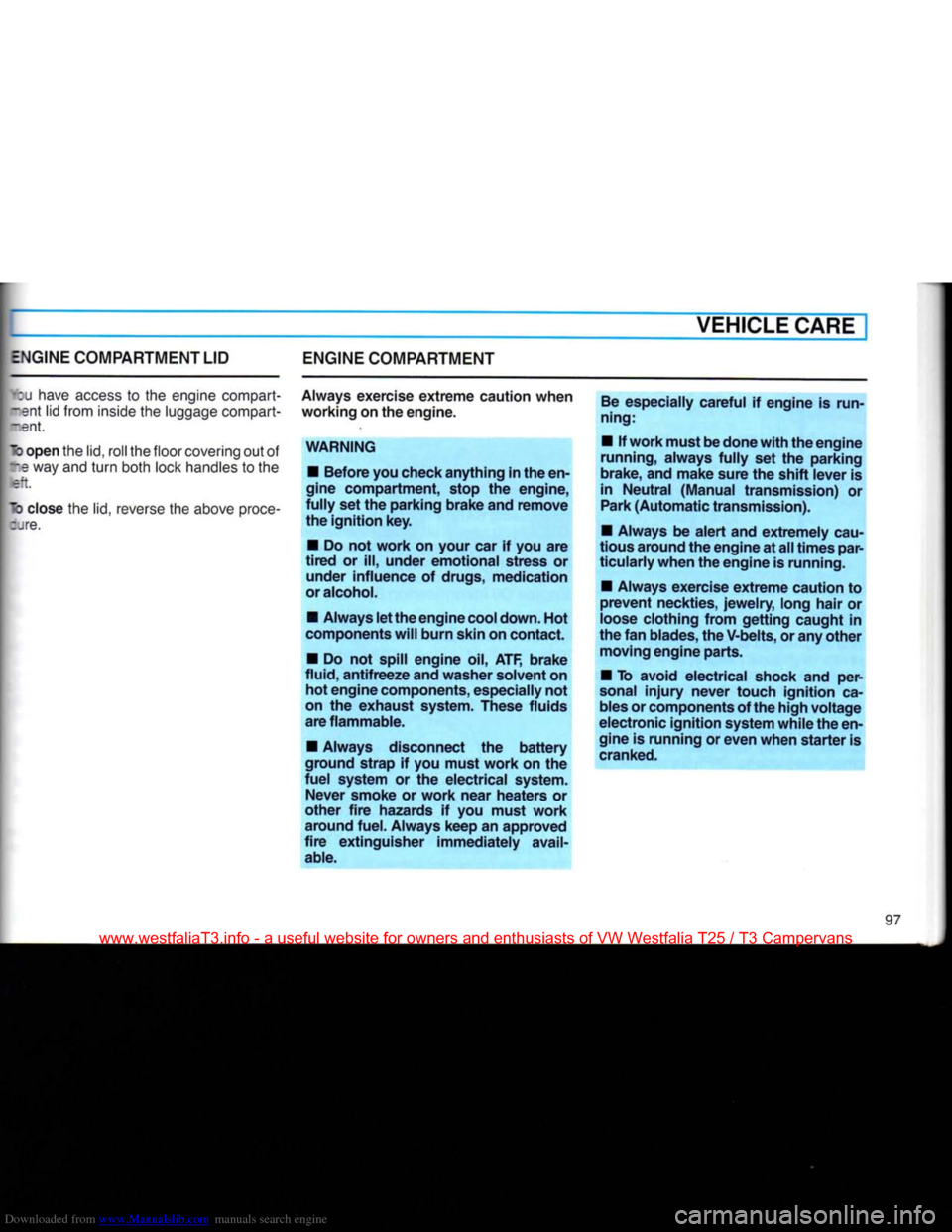
Downloaded from www.Manualslib.com manuals search engine
VEHICLE
CARE
ENGINE
COMPARTMENT LID
mu
have access to the engine compart-
•Mit
lid from inside the luggage compart- -ent.
"lb
open the
lid,
roll the floor covering out of
~9
way and
turn
both lock handles to the
Tb close the lid, reverse the above proce- ;jre.
ENGINE
COMPARTMENT
Always exercise extreme caution when
working on the engine. WARNING
•
Before you check anything in the en
gine compartment, stop the engine,
fully set the parking brake and remove
the ignition key.
•
Do not work on
your
car if you are
tired or ill, under emotional stress or under influence of drugs, medication
or alcohol.
•
Always let the engine cool down. Hot
components will burn skin on contact.
•
Do not spill engine oil, ATF, brake
fluid,
antifreeze and washer solvent on hot engine components, especially not
on the exhaust system.
These
fluids
are
flammable.
•
Always disconnect the battery
ground strap if you must work on the
fuel
system or the electrical system.
Never
smoke or work near heaters or
other fire hazards if you must work
around
fuel.
Always keep an approved
fire extinguisher immediately
avail
able.
Be
especially careful if engine is run
ning:
•
If work must be done with the engine
running, always fully set the parking
brake,
and make sure the shift lever is
in Neutral (Manual transmission) or
Park
(Automatic transmission).
•
Always be alert and extremely
cau
tious around the engine at
all
times par
ticularly when the engine is running.
•
Always exercise extreme caution to
prevent
neckties,
jewelry,
long hair or
loose clothing from getting caught in
the fan blades, the V-belts, or any other
moving
engine parts.
•
To avoid electrical shock and per
sonal
injury
never
touch ignition ca
bles
or components of the high voltage
electronic ignition system while the en
gine is running or even when starter is
cranked.
97
www.westfaliaT3.info - a useful website for owners and enthusiasts of VW Westfalia T25 / T3 Campervans
Page 163 of 165

Downloaded from www.Manualslib.com manuals search engine
ALPHABETICAL INDEX
page
Introduction 2
Instrument illumination 46
Instrument panel 4 Instruments 40
Interior light 63,133
Jack and tools 123 Jack points 126
Keys 7
Kickdown 37
Lane changer 48
License plate lights 133 Lifting vehicle 140
Light switch 46 Light alloy wheels 92
Lights 46,130
Locks 7
Lubricants 98
Luggage compartment 28
Maintenance 95
Maintenance booklet 2
Manual Transmission 32 Manual Transmission Oil 102
Mirrors 13
Notes to owner 2 page
Octane rating 86
Oil change 100
Oil filter changing 101 Oil pressure warning light 43
OXS (Oxygen sensor) 144
Parking 31,145
Parking brake 31 Pedals 29
Power steering 103
Power windows 12
Radio 5, 135
Rear lid 11 Rear seat bench/bed combination 26
Rear view mirrors 13
Rear window defogger 47
Rear window wiper/washer 50
Refill Tank 105
Reverse 32
Roof rack 68
Safe driving hints 70
Safety belts 14
Safety belts warning light 18
Safety compliance sticker 151
Seats 20 Secondary heat exchanger 53
Selector lever 35 page
Service manuals 152 Side marker lights 132
Sliding door 10 Sliding roof 62
Sliding windows 12
Snow chains 119 Spare wheel 124
Spark plugs 146
Speedometer 40
Speed ranges 69
Starter switch 38 Starting procedures 39
Steering lock 38
Stopping engine 39
Sunroof 62 Sun visors 67
Switches 46
Swivel seats 22 Syncro Differential lock 33
Driving with the-all-wheel-drive . . 75
Snow chains 119
Technical Information 142 Towing 139
Tachometer 41
Tail lights 132
Technical data 146
www.westfaliaT3.info - a useful website for owners and enthusiasts of VW Westfalia T25 / T3 Campervans